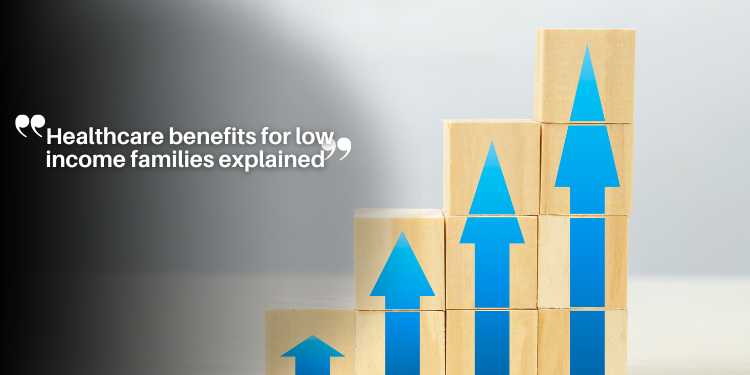Healthcare benefits for low income families explained

Healthcare benefits for low income families provide essential support for accessing medical services, helping to alleviate financial burdens associated with healthcare costs and ensuring families receive necessary care.
Healthcare benefits for low income families play a crucial role in ensuring access to essential medical services. Have you ever wondered how these programs can alleviate financial burdens? Let’s explore the options available to help families in need.
Understanding healthcare benefits
Understanding healthcare benefits is essential for families, especially those with low income. These benefits can offer crucial support for medical expenses and access to necessary services. By grasping how they work, families can navigate their options better.
What Are Healthcare Benefits?
Healthcare benefits refer to various types of coverage provided to individuals or families to help pay for medical expenses. They can significantly reduce financial burdens and improve health outcomes. Knowing the kinds of benefits available is the first step towards making informed health decisions.
Types of Healthcare Benefits Available
- Insurance coverage through government programs
- Subsidies for private health insurance
- Free or reduced-cost community health services
- Prescription drug assistance programs
Each of these benefits plays a vital role in ensuring that families can address their health needs without overwhelming costs. When families utilize these options, they can receive the medical care necessary to lead healthy lives.
Additionally, healthcare benefits often include preventive services, which are crucial for maintaining good health. These services might involve vaccinations, screenings, and check-ups that can catch health issues early on.
Eligibility for Healthcare Benefits
Eligibility for various programs varies. Low income families often qualify for numerous options based on their income level, family size, and other factors. It’s important for families to check their eligibility by contacting state or local health departments or visiting official websites.
Moreover, many families may not be aware of all the benefits they qualify for. Seeking guidance from community organizations can provide valuable assistance in understanding these programs better. This knowledge empowers families to make the most of available resources.
Eligibility criteria for low income families
Understanding the eligibility criteria for healthcare benefits is essential for low income families. Different programs have unique requirements, which can feel overwhelming. By learning these criteria, families can better navigate the options available to them.
Key Eligibility Factors
Eligibility often depends on several factors. The most common include income level, family size, and residency status. These elements help determine which benefits a family can access.
- Income level: Families must typically meet specific income limits to qualify. This is often based on the federal poverty level.
- Family size: The number of people in a household can affect the income threshold and eligibility.
- Residency: Many programs require applicants to be residents of the state where they are applying for benefits.
Furthermore, some programs might require documentation to prove eligibility. This might include pay stubs, tax returns, or identification documents. Having these ready can streamline the application process.
Exceptions and Special Circumstances
Occasionally, exceptions exist that allow certain families to qualify even if they slightly exceed the standard criteria. Factors such as disability, temporary unemployment, or having a dependent child can sometimes result in eligibility for more benefits.
Low income families should reach out to local health departments or community organizations to learn more about their specific situations. These resources can provide crucial support and clarification regarding eligibility.

Types of available healthcare services
There are various types of healthcare services available to low income families, each designed to meet specific needs. Understanding these options helps families access the care they require without facing financial hardship.
Primary Care Services
Primary care services are crucial for maintaining overall health. These services often include regular check-ups, immunizations, and screenings. Families can visit clinics where they have access to general practitioners who help manage everyday health concerns.
- Routine health assessments
- Preventive care and screenings
- Management of chronic diseases
Having regular access to these services ensures that families stay informed about their health and receive timely interventions when necessary.
Emergency Services
In critical situations, emergency services are vital. Hospitals and urgent care centers are equipped to handle medical emergencies, providing immediate attention for conditions that require rapid care. Knowing where to go in an emergency is essential for every family.
Additionally, many hospitals offer financial assistance programs for low income patients. This support helps families manage the costs associated with emergency care.
Mental Health Services
Mental health services are equally important, as they provide support for emotional and psychological issues. Counseling, therapy, and psychiatric services are available through community health centers and private practices.
- Individual and group therapy
- Support for anxiety and depression
- Substance abuse treatment programs
These services help families cope with challenges they may face, promoting overall well-being.
Specialty Care Services
Specialty care services are also available for specific health issues, such as dental, vision, or pediatric care. Accessing these services is often essential for comprehensive health management.
Low income families should be aware of these options and seek assistance to cover the costs. Many programs provide financial aid or sliding scale fees based on income, making healthcare more accessible to those in need.
How to apply for healthcare benefits
Applying for healthcare benefits can be straightforward if you know the right steps. Many low income families may feel unsure about how to start, but understanding the application process can make a big difference.
Step-by-Step Application Process
The first step is to determine which program you are eligible for based on your income and family size. Families can check their eligibility through official websites or local agencies. This will help narrow down the options available.
- Visit state health department websites for specific program details.
- Gather necessary documents, such as income proof and family information.
- Complete the application form accurately.
Once you complete the application, you can submit it online, via mail, or in person at designated offices. Ensure that all required documents are included to avoid delays in processing.
Assistance with the Application
If you need help, community organizations and healthcare navigators are available to assist. They can guide you through the process, ensuring you understand each requirement. These resources can simplify the paperwork involved and answer any questions you may have.
Sometimes, you may need to appeal a decision if your application is denied. Understanding your rights can help you make informed decisions throughout the application process. Staying organized and proactive will make the journey smoother and less stressful.
Follow Up and Maintain Benefits
After submitting your application, it’s essential to follow up regularly. Check the status of your application and keep copies of all communications. Once you receive approval, familiarize yourself with how to maintain your healthcare benefits. This may include updating your information annually or after any significant changes in your family situation.
FAQ – Frequently Asked Questions about Healthcare Benefits for Low Income Families
What are healthcare benefits for low income families?
Healthcare benefits provide financial assistance and access to medical services for families with limited income, helping them maintain their health.
How can families apply for these healthcare benefits?
Families can apply by checking eligibility on state websites, gathering necessary documents, and submitting an application either online or in person.
What types of services are typically available under these benefits?
Services often include primary care, emergency services, mental health support, and specialty care to address various health needs.
Can families receive assistance in understanding the application process?
Yes, community organizations and healthcare navigators can provide guidance and support throughout the application process to ensure families understand their options.







